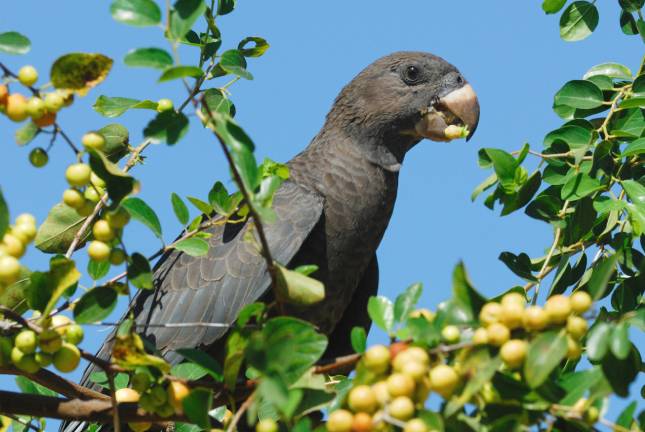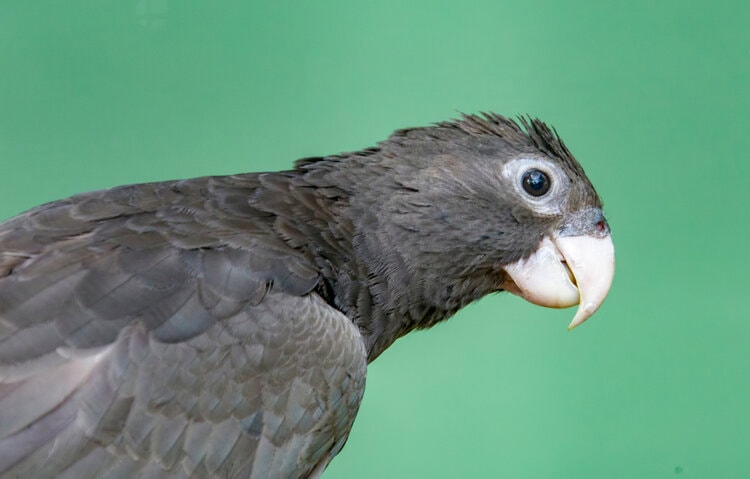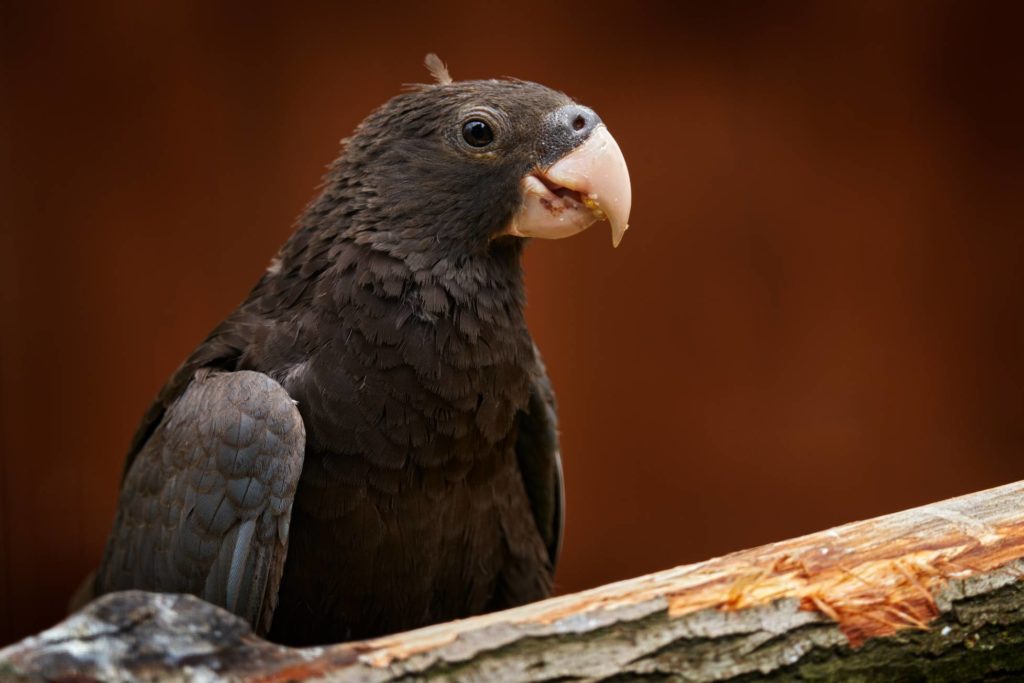
If you’re a parrot lover, you might be trying to broaden your horizons to find a beautifully unique bird to call your own. The vasa parrot has a completely unique look with its dark, neutral plumage and unusually long neck.
Vasa parrots are relatively quiet birds with big hearts and active personalities. These guys will get just as attached to you as you are to them. Before you even start your local search, let’s learn more about this fascinating bird.
 Species Overview
Species Overview
| Common Names: | Vasa Parrot, Black parrot |
| Scientific Name: | Coracopsis |
| Adult Size: | 20 inches |
| Life Epectancy: | 30 years |
Origin and History
Vasa parrots live in the wild throughout parts of Madagascar. There are two types of Vasa parrots—the greater and the lesser.
Greater vasa parrots live in dry deciduous forests, living in polyandrous groups. The lesser vasa instead prefers a humid, coastal climate with a tropical habitat.
These parrots have a unique capability—they can use a form of tool construction—holding small stones in their talons to grind seashells to powder for extra calcium during the breeding season.
Vasas are not highly prevalent in the bird trade, so their rarity adds to their beauty.

Temperament
Many bird lovers adore the vasa parrot because it is so friendly. Several parrot species gravitate towards one person in particular, but this parrot is the opposite. They are charming and happy-go-lucky, warming any heart they encounter.
They tend to be very affectionate with every member of the household. They might have their preferences, but they generally get along with everyone. Vasas really just want to be the life of the party.
Your family is sure to get many giggles out of this bird. They have very theatrical actions and love to be the center of attention. They are comical and playful, making them very rewarding pets for just about any age.
However, because of their unique set of needs, they do best with mature children to care for them properly. These guys thrive on mutual respect and good care.
Speech & Vocalizations
The vasa parrot doesn’t have nearly as many vocalizations as some species. Rather than being extremely loud and bloodcurdling, their vocalizations tend to be within a normal range and don’t disrupt the household.
If you are looking for a parrot that can mimic many different words, this isn’t the right choice. These parrots do not learn an extensive vocabulary, although they can learn certain words with enough training.
On a typical day, these parrots express themselves with lots of whistles, squeaks, and other mild auditory communications.
Vasa Parrot Colors and Markings
Since there are two species of this bird, their looks vary slightly, depending on which you have. All vasas have a somewhat scraggly appearance, with loose feathers and blunted tails.
Greater Vasa Parrot
The greater vasa parrot stands approximately 20 inches long with brownish-black plumage and a great tent to underneath of the wings.
Lesser Vasa Parrot
Even though these birds have dark, full plumage, they really transition into a different look during mating season. These birds are regularly nearly black to dusty gray.
However, when it’s time to pick up a mate, the females start to lighten up to nearly goldish brown and develop a bald spot on the top of their heads. Males’ beaks can turn very light to white at this time.
 Caring for the Vasa Parrot
Caring for the Vasa Parrot
When you are taking care of your parrot, there are several areas to consider. You must build the correct type of atmosphere so your bird can thrive and be happy in captivity.

Cage Size
The vasa parrot closely matches the African gray in size, but they have incredibly long necks. These medium-sized parrots need tall, vertical cages to accommodate them.
At a minimum, they require a space that measures at least 36” x 24” x 36”. However, the bigger, the better—and always make sure the cage is longer vertically than horizontally.
Perches
Rather than having your Vasa stuck in a cage all day, you can buy a perch for them while they explore your home. They will love the freedom of being out free but still have their own space to claim.

Avian Healthcare
Parrots cannot go to a traditional veterinarian where you might have your dog or your cat treated. These birds need specialized care from professionals who are very familiar with their anatomy and health concerns.
Your avian veterinarian would be considered an exotic practice. So, before you even buy your parrot, it is essential to locate an office around you that will provide medical treatment, if needed.
Entertainment
Parrots are incredibly social animals that love to play. The vasa parrot is one of the most active, adventurous spirit breeds. You want to make sure that you have lots of things to stimulate their brain and body.
You can buy or make them various toys, puzzles, and shiny objects to keep for their own.
Flight Feather Clipping
Every 1-3 months, your parrots will need to have their flight feathers trimmed to ensure the bird’s safety. If you do not feel confident performing this action at home, always seek professional help.
Cutting the wrong feathers or cutting them at different lengths can lead to issues for your bird. Lack of clipping can also get your parrot into trouble, flying into open fans, or even escaping through a cracked door.
Common Health Problems
Any bird lover knows that these creatures can be quite finicky in terms of health. Their life in captivity is so drastically different from that in the wild. With proper diet, exercise, and care, these parrots can remain relatively healthy. Annual checkups are helpful to ensure that your parrot is on par with its life stage.
Vasa parrots are especially susceptible to a problem called psittacine beak and feather disease. This viral condition is very contagious and causes diarrhea, weight loss, depression, abnormal feathers, beak changes, and lack of immunity. Ultimately it can lead to death.

Diet and Nutrition
A proper diet is critical when you’re caring for your parrot. Because these birds cannot get what they would in the wild, it is your responsibility as an owner to ensure that they receive access to all the key nutrients that will keep them healthy and strong.
Like many other parrots, vasas need a diet of seeds, grains, fruits, and veggies. You’ll want to make sure that you give the proper ratios—a majority of their daily intake should be commercial pellet-based food with fresh foods as a supplement (offered daily).
You can also spruce up their menu by offering occasional sweet treats made with honey. These parrots have incredible appetites, so you won’t have to worry about leaving them hungry.
Exercise
Exercise is incredibly important for these birds, especially considering that they spend the majority of their time in a cage. Daily time out of their enclosure is a must!
They need time to beat and stretch their wings to maintain muscle function and joint mobility. They also need room to wander, climbing ladders, taking floor adventures, and perching on random objects in your home.
It’s best to encourage playfulness since they love to be interactive while exercising. You can sing, dance, play with toys, and even take a walk with your vasa.
Where to Adopt or Buy a Vasa Parrot
These parrots are incredibly rare and locating one at a pet shop or a breeder can be a little bit tricky. But with enough research, you can secure a way to bring one of these cuties home to you.

Adoption
Vasas have pretty long life spans, and some people can’t keep up with the commitment. Many parrots find their way into shelters and rescues every year. There is a good chance that you might be able to locate this particular species in a shelter or rescue near you.
But there is an equal chance that you might have to travel. Many birds that you buy this way come with the necessary care and supplies, such as cages. This can cut out high costs for potential owners.
However, you have to consider that the bird will likely be fully grown and might take longer warming up to you than a baby. The average cost for adoption ranges between $200 to $500.
Breeder
If you find a vasa parrot breeder, you can secure a hatchling for yourself. You need to make sure that you find a reputable breeder that delivers quality, healthy parrots of sound temperament. In general, the cost to buy is going to be quite high as this breed is rare.
Some breeders will also sell birds that they have used for reproduction once they pass their prime. Ultimately, it is up to you, depending on what exactly you’re looking for. Costs vary quite a bit, ranging from $1,500 to $1,700.
Pet shops
Buying a parrot from a pet shop might be one of the options we recommend the least. Many birds become unhealthy in transition. These birds can become stressed very quickly, creating permanent behavioral issues. They can pick up many diseases or other health concerns along the way as well.
Always make sure to check the bird over for healthy feathers, bright eyes, and a pleasant temperament before committing.
Because pet shops are looking to make a profit, you might notice that the prices are much higher in some cases, opposed to going to a breeder.
Conclusion
These fun-loving, playful parrots will charm you with their curiosity and energy. They make a perfect pet for growing families and single owners alike.
If the dusty-colored vasa seems like a perfect fit for you, then it’s time to start the search. Keep in mind that locating one of these remarkable birds could very well require travel. They are super rare but worth the extra effort to add one of these unique birds to your home.
Featured Image Credit: Hugh Lansdown, Shutterstock

 Species Overview
Species Overview







